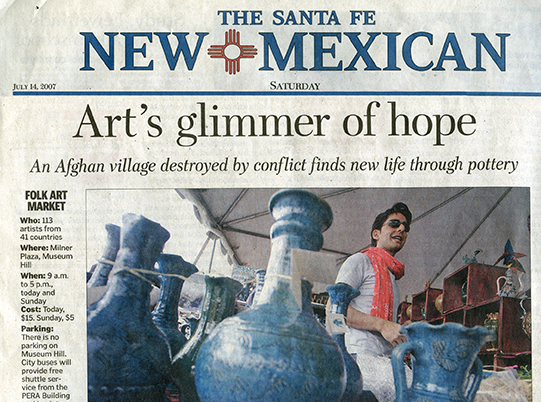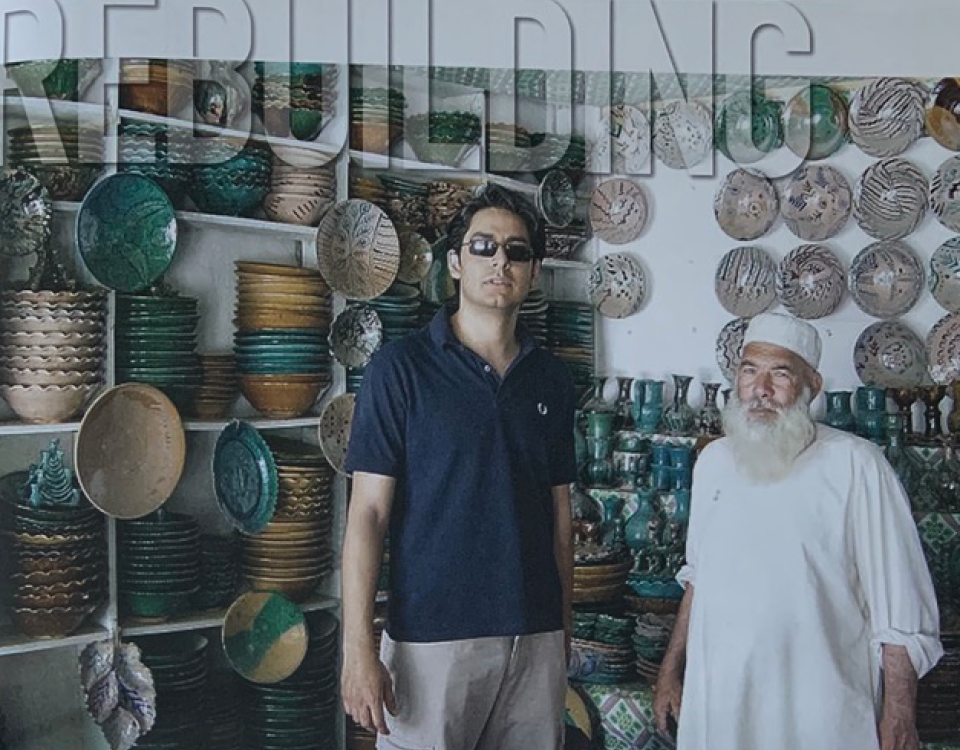Art’s Glimmer of Hope

Art’s glimmer of hope
By Natalie Storey, The New Mexican, July 13, 2007
An Afghan village destroyed by conflict finds new life through pottery
He was 8 when he saw the government soldiers hiding behind fences near his school with their guns cocked.
“Go away,” they told Ali Istalifi and his friends. “Get out of the way.”
The school was near the presidential palace in Kabul, Afghanistan. Every day after the Soviet Union invaded the country, residents faced the danger of a coup d’état and all-out war.
When school employees began asking students whether they knew any of the fighters resisting the newly installed communist government, Ali’s parents, who were art dealers, decided it was time to go. It was the beginning of his country’s decent into chaos, but at the time nobody predicted how bad it would get.
It also was the beginning of a long journey that led Ali to this weekend’s Santa Fe International Folk Art Market, where he will be selling traditional pottery from his hometown.
Ali emigrated to the United Kingdom with his mother and brother. His father, Abdul Ahmad Istalifi, would stay behind. The elder Istalifi lived through the civil war that followed the Soviet years and watched as the family’s village, Istalif, 45 minutes north of Kabul, was burned to the ground by the Taliban. Later the Americans would come, but rebuilding efforts by aid groups ignored the ancient village, which before the wars had been famous for its pottery and other handicrafts.
When Ali, now 28, returned to his family village in 2003, he found a ghost town of rubble piles inhabited by wild dogs. The village had been forgotten, and its people spread throughout the country.
“When I finally went back and saw the village I was shocked,” he said this week. “It was like and archaeological dig. There was nothing but rubble.”
Ira and Sylvia Seret, who sell imported goods in downtown Santa Fe, had first visited the village and befriended the Istalifis in the 1970s. When they heard about the condition of the village, they were determined to help father and son rebuild the town. With a budget of $150,000, provided by the Seret’s Jindhag Foundation, Ali and Abdul Istalifi rebuilt all 120 shops in the village square. By late 2004, artisans began moving back. Today 45,000 people inhabit the community.
The Traditional pottery from the town, exported out of Afghanistan for the first time, will be sold at the Santa Fe International Folk Art Market this weekend. The pottery can be found at Booth 37. The selection represents the work of 40 families, Ali said, and provides a glimmer of hope in a country where it can sometimes seem like there are few bright spots.
“What we really did was spark a fire and the flame spread everywhere,” Ali Said.
He left Afghanistan with his mother and brother when he was 11. Half the family emigrated to the United Kingdom, but Abdul Istalifi stayed behind to take care of members of his extended family. Father and son would not see each other again for many years. And Ali would lose hope of ever returning to his home.
His father-who lived through the post-Soviet civil war, the Taliban takeover and the Taliban’s subsequent removal from power by the American troops-became pessimistic about the country’s future, according to his son. Many Afghans believe the world will abandon their country as soon as it looses its prominence in political discussions, he said.
Despite billions of dollars of foreign aid, progress has been slow. Efforts to rebuild the country have been hampered by recent reports that the harvesting of opium poppies is surging and the Taliban are regrouping. The Economist recently reported that the civilian causalities caused by coalition forces fighting the Taliban also are on the rise. The magazine said at least 230 civilians have been killed this year by international forces.
Afghanistan needs well-manages aid, Ali said. “One of the groups gave the people materials to build homes,” Ali said. “It flopped because people took the material, sold it and bought food instead. They needed food.”
“We decided, let’s really do something for development,” He said. “So we asked people what they really needed, and we analyzed what the heart of the local economy was.”



